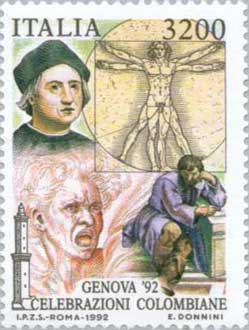.
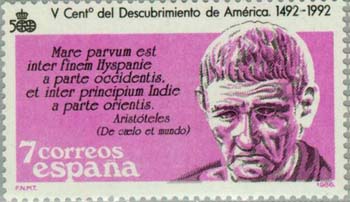
Aristotle: “there is a continuity between the parts about the pillars of Hercules and the parts about India, and that in this way the ocean is one.”
[As] for the rest of the distance around the inhabited earth which has not been visited by us up to the present time (because of the fact that the navigators who sailed in opposite directions never met), it is not of very great extent, if we reckon from the parallel distances that have been traversed by us... For those who undertook circumnavigation, and turned back without having achieved their purpose, say that they were made to turn back, not because of any continent that stood in their way and hindered their further advance, inasmuch as the sea still continued open as before, but because of their destitution and loneliness.
Strabo, Geography, ca. 7 BC
Again, our observations of the stars make it evident, not only that the earth is circular, but also that it is a circle of no great size. For quite a small change of position to south or north causes a manifest alteration of the horizon. There is much change, I mean, in the stars which are overhead, and the stars seen are different, as one moves northward or southward. ...All of which goes to show not only that the earth is circular in shape, but that it is a sphere of no great size: for otherwise the effect of so slight a change of place would not be so quickly apparent. Hence, one should not be too sure of the incredibility of the view of those who conceive that there is a continuity between the parts about the pillars of Hercules [the strait of Gibraltar] and the parts about India, and that in this way the ocean is one.
Aristotle, De Caelo, Fourth Century B.C.
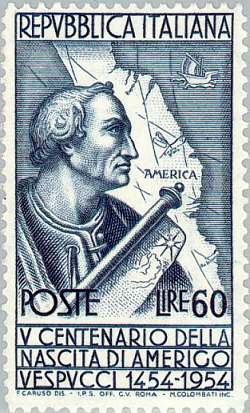
“America” a name derived from Amerigo Vespucci. A German cartographer, Martin Waldseemüller, who translated the stories of Vespucci used Vespuccis first name for the continent. Vespucci was a Italian traveler to south America claimed that he was one of the first who have visited North America.
Chronology
20000-10000 BC (It is an ice age) “Europeans” first trip to America over the Atlantic ocean. Asians use the Sibiria – Alaska road. Their identity has been identified by molecular biology studies of genetic material. Although the climate conditions are very hard travel over the ocean easier. When the ice age is over traveling over the ocean is very difficult and the story is forgotten for 20000 years..
....
1409 Ptolemy’s Geography translated into Latin
1451 Ptolemy’s Almagest new Latin translation
Ptolemy in addition to his well known works in astronomy was very important in the history of geography and cartography. Ptolemy knew that the Earth is a sphere, for his maps he produced one of the first known projections of the sphere onto a plane. His Geography remained the principal work on the subject until the time of Columbus. But he had Asia extending much too far east, which may have been a factor in Columbus's decision to sail west for the Indies. Ptolemy's "Geography" the book that inspired Columbus to attempt his voyage, and remains the model of all systematic atlases was first translated by the apostolic secretary Jacopo Angeli. In Byzantium, in the 13th century, Ptolemic maps were reconstructed and attached to Greek manuscripts of the text.
And in the 15th century, a Latin translation of this text, with maps, proved a sensation in the world of the book. A best seller both in the age of luxurious manuscripts and in that of print, Ptolemy's Geography became immensely influential. Columbus, one of its many readers, found inspiration in Ptolemy's exaggerated value for the size of Asia for his own fateful journey to the west. Ptolemy's Geography
The second reason that inspired the Admiral [Columbus] to launch his enterprise and helped justify his giving the name 'Indies' to the lands which he discovered was the authority of many learned men who said that one could sail westward from the western end of Africa and Spain to the eastern end of India, and that no great sea lay between.
Ferdinand Columbus, son of Christopher Columbus, The Life of the Admiral Christopher Columbus, ca. 1539
The Alexandria philosopher Eratosthenes estimated the circumference of the Earth to be 250,000 stadia. Other estimates of the size of the Earth followed. Some writers reported that the Greek Posidonius used the greatest height of the bright star Canopus above the horizon, as seen from Egypt and from the island of Rhodes further north. He obtained a similar value, a bit smaller. The Arab Khalif El Ma'mun, who ruled in Baghdad from 813 to 833, sent out two teams of surveyors to measure a north-south baseline and from it also obtained the radius of the Earth.
The idea of sailing westward to India dates back to the early Romans. According to Dr. Irene Fischer, who studied this subject, the Roman writer Strabo, not long after Eratosthenes and Posidonius, reported their results and noted:
"if of the more recent measurements of the Earth, the one which makes the Earth smallest in circumference be introduced--I mean that of Posidonius who estimates its circumference at about 180000 stadia, then. . . "
and he continues:
"Posidonius suspects that the length of the inhabited world, about 70000 stadia, is half the entire circle on which it had been taken, so that if you sail from the west in a straight course, you will reach India within 70000 stadia. "
Notice that Strabo used the 180000 Stadia of Posidonius even if 150 years before it was more accurately found to be 250000 Stadia by Eratosthenes. Strabo considers that the distance to India, using the smaller Posidonius value, is only 70000 stadia therefore India was not far to the west. Posidonius used the more accurate 3750 stadia for the Rhodes to Alexandria distance but kept his very inaccurate 7o 30' (the correct value is 5o 15') thus obtaining the figure of 180000 stadia for the circumference which is far too small. Another value mentioned are 240000 Stadia assuming that Posidonius used 5000 stadia instead the correct 3750 thus both errors cancel to some extend and produce a result close to the true value. However Taisbak attempts to prove that attributing this far too small value of 180000 stadia to Posidonius is unfounded.
500 years anniversary of the Columbus Voyage: The Vitruvius Man behind the Philosopher Heraclitus from Raphael's School of Athens
Columbus had an estimate of his own. Some historians have proposed that he used an argument like Strabo's, but Dr. Fischer found his claim to be based on incorrect units of distance. Columbus used an erroneous estimate by Ptolemy, who based it on a later definition of the stadium, and in estimating the size of the settled world he confused the Arab mile, used by El Ma'mun, with the Roman mile on which our own mile is based. All the same, his final estimate of the distance to India was close to Strabo's. We may never know whether Columbus knowingly fudged his values to justify an expedition to explore the unknown, or actually believed India was not too far to the west of Spain. He certainly did call the inhabitants of the lands he discovered "Indians," a mislabeling which still persists.
There is another important contribution that leads to the discovery of America. Hipparchus worked on the island of Rhodes from 161 to 126 BC. His observations and Ptolemy's model allowed the prediction of the position of stars and planets to the necessary accuracy required by sailors. Without this Columbus would less probably started the voyage to “India”
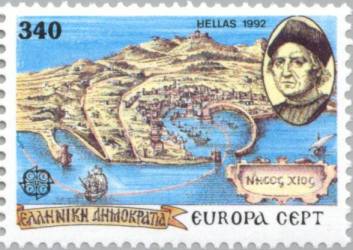
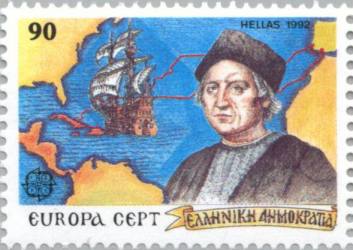
It is also interesting that Columbus probably was of Greek origin from Chios who not only could read and write in Greek. See Christophoros Columbus: A Byzantine Prince from Chios, Greece, by Ruth G. Durlacher-Wolper
If we believe Henriette Mertz, an American archaeologist, then according to the story of Apollonius Argonautica the famous Argo ship actually reached America and Colchis reality related to the tribe of Colchicourous who lived south of the Titikaka lake. (Map)
Mildred Stapley, Christopher Columbus:
Many years after Columbus's death, his son Fernando wrote that his father had studied geography (which was then called cosmogony) at the University of Pavia. Columbus himself never referred to Pavia nor to any other school; nor was it likely that poor parents could afford to send the eldest of five children to spend a year at a far-off university. Certain it is that he never went there after his seafaring life began, for from then on his doings are quite clearly known; so we must admit that while he may have had some teaching in childhood, what little knowledge he possessed of geography and science were self-taught in later years. The belief in a sphere-world was already very ancient, but people who accepted it were generally pronounced either mad or wicked. Long before, in the Greek and Roman days, certain teachers had believed it without being called mad or wicked. As far back as the fourth century B.C. a philosopher named Pythagoras had written that the world was round. Later Plato, and next Aristotle, two very learned Greeks, did the same; and still later, the Romans taught it. But Greece and Rome fell; and during the Dark Ages, when the Greek and Roman ideas were lost sight of, most people took it for granted that the world was flat. After many centuries the "sphere" idea was resurrected and talked about by a few landsmen, and believed in by many practical seamen; and it is quite possible that the young Cristoforo had learned of the theory of a sphere-world from Genoese navigators even before he went to sea.
Wherever the idea originated is insignificant compared with the fact that, of all the men who held the same belief, Columbus alone had the superb courage to sail forth and prove it true.
...
At any rate, it is certain that in 1474 or 1475 Cristoforo hired out as an ordinary sailor on a Mediterranean ship going to Chios, an island east of Greece. In 1476 we find him among the sailors on some galleys bound for England and attacked by pirates off the Portuguese Cape St. Vincent.
...
Certain it is that Columbus's absorbing interest in the unknown, mysterious west dates from his returning to Lisbon to live. Not only did he talk earnestly with men who had interests in the Atlantic isles, he studied all the available geographical works. Before the time came to leave for Spain he had read the wonderful "Relation" (or Narrative) of Marco Polo; the "Imago Mundi" (Image of the World) by Cardinal d'Ailly; the "Historia Rerum" (History of Things) by Pope Pius II.; and he had studied Ptolemy's "Geography." From this small library came all the scientific knowledge, true and false, that Christopher ever had. From these he built up whatever theories of the universe he may have laid before the sovereigns of Spain.
Was Columbus from Chios ? "Columbus never said he was from Genoa but from the Republic of Genoa. The island of Khios was under the Genoese rule (1346 - 1566 AD), for the period of his life, and therefore it was part of the Republic of Genoa. A lesser known fact is that there exists a village named Pirgi in the island of Khios where to this day many of its inhabitants carry the surname "Colombus".
Columbus Mystery Nearly Solved...
LINKS
Columbus and Celestial Navigation , The Columbus Navigation Homepage
ANCIENT GREEKS IN AMERICA ??? , The Kyrenia Ship in New York
Who really discovered America ?
THE INFLUENCE OF THE HELLENIC CULTURE IN THE CONFORMATION OF THE COLOMBIAN CULTURE
On Eratosthenes, Maui's Voyage of Discovery, and Reviving The Principle of Discovery Today
"Famous Americans"
Juan de Fuca ( Apostolos Valerianos )
See also
The Greeks who sailed with Magellan’s fleet
German Reports
WAR KOLCHIS IN AMERIKA ? , ... KOLCHIS WAR IN SÜDAMERIKA ...! (Spekulationen über die Argonauten und Amerika)
| Ancient Greece
Science, Technology , Medicine , Warfare, , Biographies , Life , Cities/Places/Maps , Arts , Literature , Philosophy ,Olympics, Mythology , History , Images Medieval Greece / Byzantine Empire Science, Technology, Arts, , Warfare , Literature, Biographies, Icons, History Modern Greece Cities, Islands, Regions, Fauna/Flora ,Biographies , History , Warfare, Science/Technology, Literature, Music , Arts , Film/Actors , Sport , Fashion --- |

